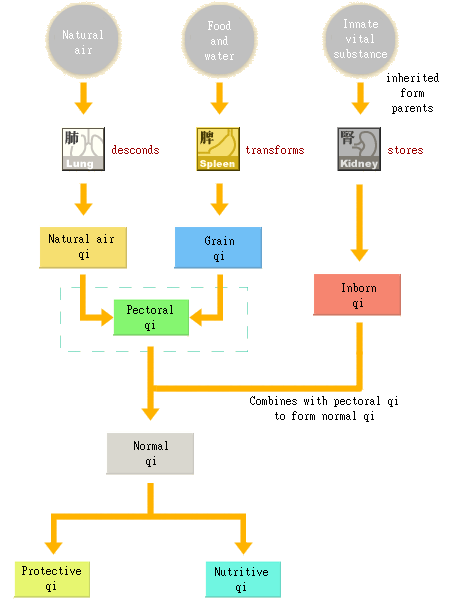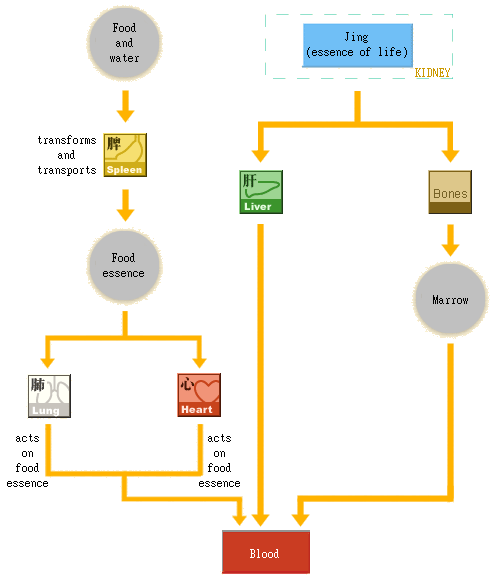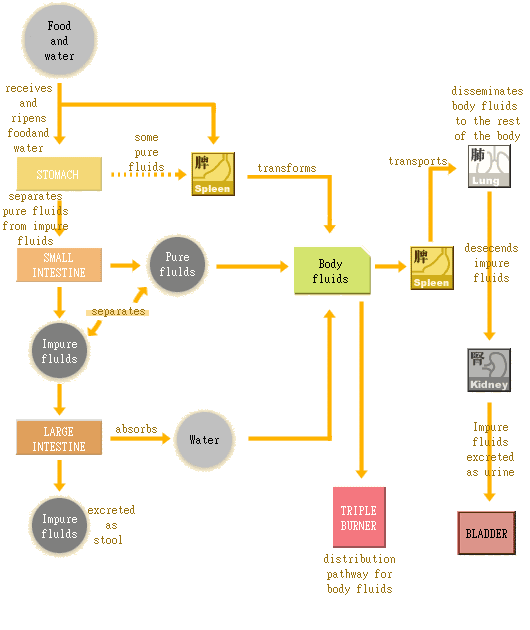Understand Qi (Vital Energy) from a TCM Perspective
Western medicine places strong emphasis on the physical structures of the body, which are made up of different organic and inorganic substances, proteins, tissues and cells. These substances form the physiological basis of humans. Traditional Chinese medicine (TCM), on the other hand, views life a little differently. Instead of emphasizing discrete body components with cells being the basic building blocks, the body is seen as a whole entity with connecting parts that work together to sustain life. Some parts have more energetic properties while others have more material characteristics. The interaction between the different parts is vital to the individual’s being so they are often referred to as fundamental substances. Qi (pronounced chee), blood and body fluids are the most important fundamental substances necessary for life.
The ancient Chinese people believed qi was the most fundamental entity making up the world. They thought everything in the universe resulted from the movement and change of qi. The Chinese character for “Qi” is the same word used for air or gas, and it is thought to have the same properties as these substances. Qi can be interpreted as the “life energy” or “life force,” which flows within us. Sometimes, it is known as the “vital energy” of the body.
In TCM theory, qi is the vital substance constituting the human body. It also refers to the physiological functions of organs and meridians. In fact, it may be difficult to find one equivalent English word or phrase that completely describes the nature of qi. Most often, qi is best defined according to its functions and properties.
The Origin of Qi
Human qi comes from two main sources. The first source of qi is inherited from our parents at conception. It is known as the “innate vital substance”. The second source is derived from essential substances in nature such as the air we breathe, food and water. Both the inherited and the acquired vital energies are further processed and transformed by the organs.
The kidney first sends the innate vital substance upwards where it combines with food essence derived from the spleen. It further mixes with the fresh air from the lungs where it finally forms into qi of the body.
By understanding how qi is formed, TCM has identified two important factors necessary for maintaining health. By eating a healthy diet and breathing fresh air, the body extracts their most valuable essences and uses them to help form the vital energy. Following these simple principles are the first steps towards creating a healthy balance in the body.
Functions of Qi
- 1. Promoting
Just as wind (highly active air) provides energy to push the sails of a boat or turn the turbine of a windmill, qi provides the active, vital energy necessary for the growth and development of the human body and to perform the physiological functions of the organs, meridians and tissues. In addition, qi promotes the formation and circulation of blood and supports the metabolism of body fluid. If there is a deficiency of qi, its promoting functions are weakened. As a result, growth and development can be affected or delayed, the organs and meridians cannot function properly and blood formation is hampered, leading to a series of health problems.
- 2. Warming
In a gaseous state, air contains more kinetic heat energy than in its liquid state. Like air, qi also contains heat energy for the body. Being a heat source, qi warms the body and keeps it at a constant temperature so normal physiological functions can take place. Deficiency of qi can lead to a lowered body temperature, intolerance of cold and cold hands and feet.
- 3. Defending
In TCM, one of the main causes of disease is the invasion of “Evils”.”Evils” are environmental factors that lead to illness. They are classified as wind, summer heat, dampness, dryness, cold and fire. By resisting the entry of ‘ illness evils” into the body, qi defends against their attack and maintains healthy physiological functions. In western terms, this qi defending function acts like the immune system.
- 4. Consolidation and Retention
Qi consolidates and retains the body’s substances and organs by holding everything in its proper place. First, qi keeps the blood flowing within the vessels and prevents it leaking out into the tissues. Secondly, qi controls and adjusts the secretion and excretion of sweat, urine and saliva, and keeps body fluids from escaping the body. Thirdly, qi consolidates and stores sperm to prevent premature ejaculation. Lastly, qi consolidates the organs and stops them from descending into a position where they cannot function properly. If qi is deficient, the consolidating function is weakened, leading to various kinds of health problems such as haemorrhage; frequent urination, premature ejaculation and stomach or kidney prolapses (where the organ sinks).
The promoting and consolidating functions work in a complementary manner. For example, qi promotes blood circulation and the distribution of body fluids, but it also controls and adjusts the secretion of fluid substances. The balance between these two functions is essential for maintaining a healthy blood circulation and water metabolism.
- 5. Transforming
Qi also possesses vaporization or ” transformation” functions, which are important for the metabolism of fundamental substances. As suggested by these words, qi may “vaporize” substances in the body and transform them into essence or vital energy. For example, certain actions of qi allow food to be changed into food essence, which is in turn transformed into different types of qi and blood. Indigestible food and waste are also transformed by qi into urine and stools for excretion.
Movement of Qi
The four directions of qi movement are up, down, outward and inward. These movements are so important that once qi can no longer travel in these directions, life will come to an end.
Each organ has different specialized movements. For example, spleen qi ascends the pure part of digested food from the stomach for transformation into nutritional essence. Stomach qi, on the other hand, pushes food downwards in order to remove its impurities. Some organs, like the lungs, perform movements in all four directions. Lung qi moves in and out during breathing. However, when disseminating nutritional essence to the body, lung qi ascends and then descends when liquefying waste to be sent to the kidneys.
The different movements of qi work in a coordinated manner to maintain a harmonious balance. The ascending balances the descending movement while the outward balances the inward movement. Balanced movement is important for promoting the physiological functions of different tissues, organs and meridians. Disharmonious movement of qi leads to health problems. For example, insufficient downward movement of lung qi causes a cough. When stomach qi cannot descend nausea and vomiting occurs.
Types of Qi
Qi is further classified according to its type. The four types are inborn qi, pectoral qi, nutritive qi and protective qi.
- 1. Inborn Qi
Inborn qi is the most original, essential and vital type found in the human body. It possesses prenatal and congenital properties. After conception, “congenital essence” (an essential vital substance inherited from parents) is stored in the kidney, the place from which inborn qi originates. Inborn qi is further nourished by “acquired essence” (food essence derived from digestion) of the spleen and stomach. After this process is complete, inborn qi is ready to travel to the entire body to exert its effects. Starting from the portion between the two kidneys, known as the “vital gate”, the qi moves through the triple burner and circulates through the organs, muscles, skin and meridians providing the power source for all of life’s activities.
- 2. Pectoral Qi
Pectoral qi is stored in the chest. It is formed by combining fresh air inhaled by the lungs and food essence derived from the spleen and the stomach. Because pectoral qi concentrates in the chest, it can penetrate the blood vessels of the heart and lungs and move outward during expiration and inward during inspiration. By flowing through the respiratory tract, pectoral qi supports the breathing function of the lungs and affects how loud the voice can be. Its ability to flow through the blood vessels and the heart is important in regulating the heartbeat and supporting the circulation of other types of qi and blood. Pectoral qi also plays a role in keeping the body warm and influences the activities of the limbs.
- 3. Nutritive Qi
Nutritive qi, as its name suggests, supplies nourishment to the body. It mainly circulates through the blood vessels with the blood. Sometimes this combination of nutritive qi and blood is referred to collectively as “nutritive blood”. Nutritive qi mainly comes from food essence derived by the spleen and stomach’s transformation and transportation properties. Starting from the middle burner, nutritive qi goes to the lungs where it enters the main circulation. Nutritive qi has yin properties so it can form into materials needed by other parts of the body. For example, its close relationship with blood allows it to provide some of the necessary substances needed to produce new blood. Nutritive qi also provides the needed nutrients to support the physiological functions of the organs.
- 4. Protective Qi
Protective qi protects against evils. As previously mentioned, evils are environmental factors that lead to illness. In western terms, protective qi functions like the immune system, which helps prevent disease from occurring or spreading. Unlike nutritive qi, protective qi has yang properties, because it has more functional characteristics.
Protective qi also comes from the food essence derived by the spleen and stomach. It moves outside the blood vessels and circulates in different areas from nutritive qi. Internally, it will be distributed to the diaphragm and scattered around the chest and abdominal cavities. Externally, it moves between the skin and muscles providing protection. Protective qi not only guards against illness and disease but also regulates the sweat glands and pores and provides nourishment for the skin, hair and muscles.
Although nutritive and protective qi share the same origin, their flow directions, as previously described, are opposite to one another. By balancing their nutritive (yin) and protective (yang) functions, healthy sweating, temperature control and defence functions are maintained.
Flow Chart of Qi Formation
Understand Blood from a TCM Perspective
In western medicine, blood is composed of red blood cells, white blood cells, platelets, nutrients, other proteins, electrolytes and water. Its functions are based on the characteristics of these individual components. Some of these functions include distributing hormones, carrying oxygen and energy (glucose) and supporting the immune system.
Instead of studying things at a cellular level, TCM focuses on the body as a whole. Blood is viewed simply as the red fluid inside the blood vessels that provides nutrition for the body. The nutrients transported by blood are not restricted to physical materials. Its meaning can be extended to anything that provides nourishment to the body.
The Origin of Blood
Blood mainly originates from food essence and Jing (the essence of life associated with the growth and development of the body). First, digested food is turned into food essence by the stomach and spleen’s transforming functions. It is then transported upwards by the spleen to the lungs where it turns into blood with the help of the heart and lungs. Eating a balanced and healthy diet is extremely important, because of the spleen’s role in the production of qi and blood.
A second source of blood comes from Jing, which is stored in the kidneys. Jing travels to the bones where its turns into healthy and strong marrow. The marrow in turn produces the blood. Jing also goes to the liver to be transformed into clear blood.
Functions of Blood
Blood is mainly responsible for nourishing and keeping the body moist. Internally, it circulates to the organs, and externally, it flows to skin, flesh, bones and muscles. Its detailed functions are as follows:
- 1. Providing nutrients for organs, tissues and meridians
With sufficient nourishment from the blood, organs and tissues can function normally resulting in a healthy glow in the skin, cheeks, and hair. Nails, muscles and bones also rely on blood nourishment to remain strong and healthy.
- 2. Maintaining healthy body movement and sensation
The Huang Di Nei Jing, a famous Chinese medicine text from the Han dynasty, says, “Having received sufficient blood, the liver can support healthy eyesight. Having received sufficient blood, feet can walk. Having received sufficient blood, the palm can grasp hold of things. Having received sufficient blood, the fingers can pick up things.” This illustrates blood’s importance in healthy muscle movement and sensation. If blood is deficient, dizziness, vertigo, ringing in the ears (tinnitus) or limb weakness can occur.
- 3. Aiding the mind and mental activities
A good blood supply is also important for mental health. With sufficient blood nourishment, a clear mind, good spirit, fast thought processes and swift reaction times are possible. On the other hand, deficiency of blood leads to poor memory and insomnia and in serious cases causes mental disorders and psychiatric diseases.
Flow chart of Blood Formation
Understand Body Fluids from a TCM Perspective
Body fluids refer to the different kinds of physiological fluids found in the body, including fluids in the organs and tissues, gastric fluid, intestinal fluid, semen and tears. Classified as one of the fundamental substances, body fluids are essential to life’s activities.
The Origin, Distribution and Excretion of Body Fluids
According to TCM theory, body fluids originate from food and water. They are formed during digestion in the stomach and by transformation in the spleen. The small intestine extracts body fluids by further separating the pure fluids from the impure fluids contained in the food, and the large intestine contributes to the formation of body fluids by absorbing water from the stool.
Body fluids are distributed and excreted via different pathways. First, they are distributed through the spleen’s transportation function to the lungs. In the lungs they are disseminated to the rest of the body. The lungs descend fluids that become impure while circulating through the body to the kidneys. The kidneys “vaporize” the body fluids and regulate their metabolism by sending the impure wastes to the bladder to be excreted. The triple burner also acts as a distribution pathway for body fluids.
Body fluids help excrete metabolic waste and toxins produced through the metabolic functions of various organs. These fluids are usually excreted as sweat and urine. In this way, body fluids maintain a clean and healthy environment for organs, meridians and tissues.
Functions of Body Fluids
Body fluids are mainly responsible for providing moisture and nourishment to the tissues. When distributed to the surface of the body, body fluids moisten the skin and hair and maintain the smooth and elastic texture of the skin. Body fluids also moisten, nourish and protect different orifices in the body. For example, body fluids allow the eyes to blink smoothly, the nasal cavity to maintain an open airway without blockage and the lips and mouth to remain moist without becoming dry. Internal body fluids also penetrate different organs, tissues and even bone marrow to provide moisture and nourishment. The spinal cord and brain are examples of organs surrounded by body fluid that protects and nourishes them.
Disharmony of body fluids is manifested in two ways. When body fluids can no longer nourish and provide moisture to the body, symptoms such as dry skin, flaccid muscles, brittle hair, dry eyes, parched lips and a dry nose or throat occur. When there is dysfunction of distribution or excretion of body fluids symptoms can present as swollen eyelids, edema (retention of fluid in the tissues), obesity or other conditions.
Flow chart for formation of body fluids



